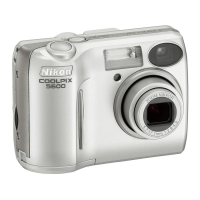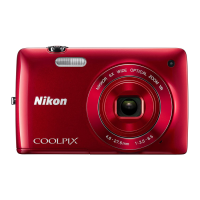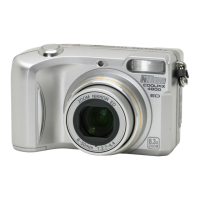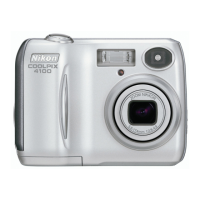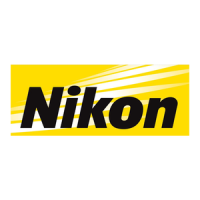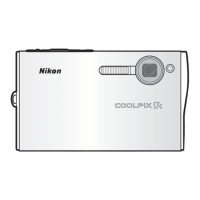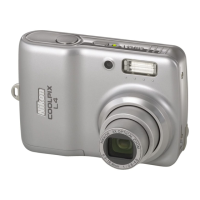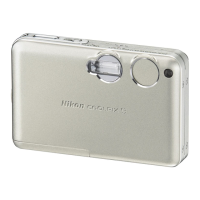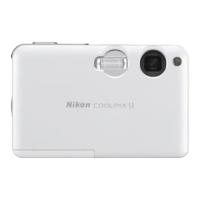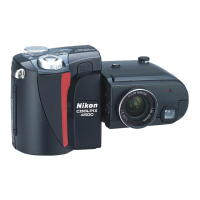
Do you have a question about the Nikon COOLPIX 4500 and is the answer not in the manual?
| Megapixel | 4 MP |
|---|---|
| Camera type | Compact camera |
| Sensor type | CCD |
| Image sensor size | 1/1.8 \ |
| Optical zoom | - x |
| Focal length range | 7.85 - 32 mm |
| Lens structure (elements/groups) | 10/8 |
| Interface | USB 1.1, AV out |
| Digital SLR | No |
| Built-in flash | Yes |
| Camera shutter speed | 8 - 1/2300 s |
| Focal length (35mm film equivalent) | 38 - 155 mm |
| Normal focusing range | 0.5 - ∞ m |
| Auto focusing (AF) modes | continuous auto focus, multi point auto focus, single auto focus, spot auto focus |
| Macro focusing range (wide) | 0.02 -? m |
| ISO sensitivity | 200, 400, 800 |
| Compatible memory cards | CF |
| Motion JPEG frame rate | 15 fps |
| Field of view | 97 % |
| Display diagonal | 1.5 \ |
| Display resolution (numeric) | 110000 pixels |
| Product color | Black |
| Battery type | EN-EL1 |
| Flash modes | auto, Red-eye reduction |
| Scene modes | beach, Museum, Night landscape, Night portrait, party (indoor), Sunset, Landscape (scenery) |
| Depth | 50 mm |
|---|---|
| Width | 130 mm |
| Height | 73 mm |
| Weight | 360 g |
Steps to prepare the camera for use.
Instructions for capturing photos.
How to review captured images.
Steps for removing unwanted photos.
Guide to installing camera software.
Tips for viewing and enjoying photos.
Guide for unpacking and initial setup of the camera.
Complete operating instructions for the camera.
Details on using the Nikon View 5 software.
Explains warning symbols for potential injury.
Warns against viewing the sun through the viewfinder.
Procedure for safe handling of equipment malfunctions.
Warning against use in environments with flammable gas.
Caution about camera strap placement to prevent strangulation.
Warning against unauthorized disassembly and advice for repair.
Guidelines for safe handling, charging, and replacing batteries.
FCC compliance statement regarding radio frequency interference.
Recommendation to use Nikon-provided interface cables.
Legal restrictions on copying and reproduction of materials.
List of trademarks and registered trademarks.
Explains manual organization and conventions used.
Identifies camera parts and their functions.
Guides users through initial camera setup and operation.
Emphasizes using only Nikon-certified accessories to prevent damage.
Visual guide to camera parts with numbered references.
Explains the usage of camera controls and the monitor display.
Instructions on how to attach the camera strap securely.
Guide for correctly inserting the camera's battery.
Emphasizes reading and following all battery safety instructions.
Information on using AC adapters and alternative batteries.
Explains the camera's internal clock power source and its reset requirements.
Explains the process and importance of formatting memory cards.
Instructions for safely removing memory cards from the camera.
Details the fundamental steps involved in taking pictures using the camera.
Explains automatic power-off feature for battery conservation.
Guide to selecting and confirming the camera's auto shooting mode.
Optional adjustments for camera settings in auto mode.
Instructions on how to frame a subject using the camera's lens.
Information about the camera's pop-up flash and its operation.
Explains the function of the swivel limit switch for lens rotation.
Guidance on choosing between monitor and viewfinder for framing.
Warning to keep fingers away from lens and flash window.
How to turn the monitor on/off and hide/display indicators.
Steps for focusing the camera and taking a picture.
Information about recording status indicators and buffer memory.
Instructions for properly storing the camera after use.
Covers viewing pictures immediately after taking them.
Notes on safe practices during picture playback.
How to quickly review the last picture taken.
What happens when no pictures are available for playback.
Operations performed in full-screen playback mode.
How to view multiple pictures as small thumbnails.
Detailed steps for installing and using Nikon View 5 software.
Prerequisites and system requirements for installing Nikon View 5.
Steps to install Adobe Acrobat Reader for viewing instructions.
How to access and read the Nikon View 5 installation guide.
Notes on upgrading or using existing versions of Nikon View.
Steps for establishing a connection between the camera and computer.
How to connect the camera directly to a computer using a USB cable.
Important checks and preparations before connecting the camera.
Ensuring adequate power during data transfer.
Steps to transfer image files from the camera to the computer.
How to choose specific pictures for transfer using Auto Transfer.
Procedures for safely disconnecting the camera from the computer.
How to transfer pictures directly from a memory card using a reader.
Steps to safely remove memory cards from readers or PC card slots.
Guide for connecting the camera to a TV or VCR for playback.
Recommendation to use an AC adapter for extended playback.
How to select NTSC or PAL video output standards.
Overview of available shooting and exposure modes.
Details the sixteen scene modes for specific shooting situations.
Explains how to adjust image quality and size settings.
Specific settings and advice for close-up photography.
Explains how to select and use different focus modes.
Guidance for macro photography and close-up focusing.
Details the autofocus system and tips for good results.
Recommends selecting the center focus area for focus lock.
How to lock focus and exposure for composition changes.
How to lock exposure independently of focus.
Instructions for using manual focus when autofocus is insufficient.
Important considerations and tips for manual focus operation.
How to use optical and digital zoom for framing shots.
Compares optical and digital zoom and their effects on image quality.
How to enable and use the digital zoom feature.
Conditions under which digital zoom is not available.
Explains the different flash modes and their usage.
Explains when the flash automatically turns off.
Information about the flash-ready lamp indicator.
Instructions and warnings related to using the built-in flash.
How to connect external flash units using the sync terminal.
Guidance on using external Nikon Speedlights.
Additional notes and precautions for the built-in flash.
Notes on flash performance for close-up subjects.
How poor lighting affects photos and how to mitigate noise.
Instructions for recording movies with the camera.
How to adjust exposure for challenging lighting and contrast situations.
Explains how the FUNC button relates to exposure compensation.
Guidance on selecting appropriate exposure compensation values.
How to adjust ISO sensitivity for different lighting conditions.
Options for deciding whether to keep or delete pictures.
How to prevent accidental deletion of images.
Detailed instructions on using playback zoom to magnify images.
Limitations and tips for using the playback zoom feature.
Steps to create smaller versions of pictures for easier sharing.
Explains limitations for creating small picture copies.
How to play back movie files recorded by the camera.
Explains playback behavior for movies recorded with the lens pointing towards the monitor.
How to record and manage voice memos for captured images.
How to view detailed information about each photograph.
Details about file naming conventions and metadata.
Displays shooting parameters like focal length and focus mode.
Displays white balance, color, sharpening, and file size.
Shows histogram and exposure details for images.
Displays focus confirmation status and areas in focus.
Detailed listing and explanation of all menu items and their functions.
Explains how to navigate and use the camera's menu system.
Covers all options for fine-tuning shooting settings.
Explains white balance and how to adjust it for accurate color.
Advanced adjustment of white balance settings.
Using preset white balance for specific lighting conditions.
Explains the different metering methods for exposure.
Explains continuous shooting modes and movie recording.
Specifics of Ultra HS and Movie recording modes.
How to use the Best Shot Selector to improve sharpness.
How to adjust image contrast and brightness.
How to adjust color saturation and create B&W/Sepia images.
How image quality and size affect memory card usage.
Explains image compression and quality settings.
Explains pixel dimensions and their impact on storage and printing.
How to save and recall custom camera settings.
How to adjust image sharpening for sharper edges.
How to configure camera settings for use with converter lenses.
Using the slide copy adapter for inverse color film viewing.
Options for managing camera exposure settings.
How to lock exposure for consistent results across multiple shots.
How to adjust exposure compensation to alter image brightness.
Options for selecting focus area and mode.
How to choose where the camera focuses.
How the camera adjusts focus automatically.
Visual confirmation of focus in the monitor.
Options for controlling optical and digital zoom.
How to enable and use digital zoom.
Setting the initial zoom position when the camera is turned on.
How to maintain a fixed aperture while zooming.
Options for controlling built-in and external flash units.
Controls whether the built-in flash pops up automatically.
How to adjust the intensity of the flash output.
Controls for built-in flash when using optional Speedlights.
How to use external flash units with the camera.
How to automatically vary settings for exposure or white balance.
How to bracket white balance settings for optimal color.
Conditions where bracketing cannot be used.
How to reduce digital noise in images.
Conditions where noise reduction cannot be used.
How to reset camera settings to factory defaults.
Controls for monitor brightness and display modes.
How to set monitor behavior at startup and during playback.
How to adjust the monitor's brightness level.
How to assign functions to the FUNC button and multi selector.
Customizing the function assigned to the FUNC button.
How to lock focus and exposure using the multi selector.
Setting the automatic power-off timer to save battery.
Controls how picture files are named and numbered.
Controls camera sound feedback (beeps).
How to format memory cards for use in the camera.
Important precautions before formatting a memory card.
How to set the camera's date and time.
How to confirm shutter release with the self-timer lamp.
Saving image metadata to a text file.
Selecting the video output standard (NTSC/PAL).
Setting the camera's display language.
Preventing accidental deletion of images or formatting.
Selecting the USB protocol (PTP or Mass Storage).
How to delete selected or all pictures and manage transfer/print markings.
Selecting specific pictures for deletion.
Important note about recovering deleted pictures.
Deleting all images from the memory card.
Removing transfer marks from all images.
Cancelling an active print order.
How to select folders for viewing images.
How to delete folders created by Panorama Assist or Ultra HS.
How to play back images automatically in a slideshow.
Adjusting the display duration of each image in a slideshow.
Adjusting the vertical perspective of images.
Limitations on applying perspective control.
Selecting the dimensions for small picture copies.
Notes on the appearance and cropping of transformed images.
Protecting images from accidental deletion.
Hiding images to exclude them from slideshows or normal playback.
Setting up print orders and specifying print details.
How to cancel an existing print order.
Choosing specific images for transfer to a computer.
How to select individual pictures for transfer.
Selecting all pictures on the memory card for transfer.
List of available accessories for the COOLPIX4500.
List of memory cards tested and approved for use with the camera.
Precautions for maintaining the camera and battery.
Guidelines for storing the camera during extended periods.
Advice for optimal battery performance and care.
Instructions for cleaning the camera's lens, monitor, and body.
Specific instructions for cleaning the camera lens.
Instructions for cleaning the camera monitor safely.
General cleaning instructions for the camera body.
Online resources for product information and support.
Common problems and their solutions for camera issues.
Solutions for issues with monitor readability.
Troubleshooting steps when the lens angle cannot be adjusted.
Reasons and solutions when the camera fails to take pictures.
Solutions for inverted images in the monitor.
Addresses issues with digital noise in images.
Troubleshooting steps when the camera's flash fails to operate.
Solutions for unnatural colors due to incorrect white balance or saturation.
Explains common error messages and their solutions.
Explains how static charge can affect camera operation.
Specifies system requirements for Nikon View 5 on Windows.
Specifies system requirements for Nikon View 5 on Macintosh.
